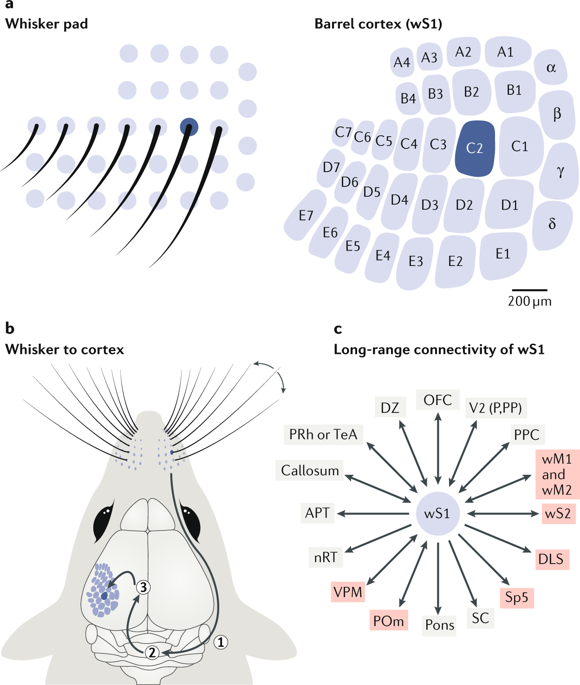当前位置:
X-MOL 学术
›
Nat. Rev. Neurosci.
›
论文详情
Our official English website, www.x-mol.net, welcomes your
feedback! (Note: you will need to create a separate account there.)
Sensorimotor processing in the rodent barrel cortex.
Nature Reviews Neuroscience ( IF 28.7 ) Pub Date : 2019-07-31 , DOI: 10.1038/s41583-019-0200-y Carl C H Petersen 1
Nature Reviews Neuroscience ( IF 28.7 ) Pub Date : 2019-07-31 , DOI: 10.1038/s41583-019-0200-y Carl C H Petersen 1
Affiliation

|
Tactile sensory information from facial whiskers provides nocturnal tunnel-dwelling rodents, including mice and rats, with important spatial and textural information about their immediate surroundings. Whiskers are moved back and forth to scan the environment (whisking), and touch signals from each whisker evoke sparse patterns of neuronal activity in whisker-related primary somatosensory cortex (wS1; barrel cortex). Whisking is accompanied by desynchronized brain states and cell-type-specific changes in spontaneous and evoked neuronal activity. Tactile information, including object texture and location, appears to be computed in wS1 through integration of motor and sensory signals. wS1 also directly controls whisker movements and contributes to learned, whisker-dependent, goal-directed behaviours. The cell-type-specific neuronal circuitry in wS1 that contributes to whisker sensory perception is beginning to be defined.
中文翻译:

啮齿动物桶状皮层的感觉运动处理。
来自面部胡须的触觉信息为夜间居住在隧道的啮齿动物(包括老鼠和大鼠)提供了有关其周围环境的重要空间和纹理信息。胡须来回移动以扫描环境(胡须),来自每个胡须的触摸信号会在胡须相关的初级体感皮层(wS1;桶状皮层)中唤起神经元活动的稀疏模式。拂动伴随着不同步的大脑状态和自发和诱发神经元活动的细胞类型特异性变化。触觉信息,包括物体纹理和位置,似乎是通过整合运动和感觉信号在 wS1 中计算的。wS1 还直接控制胡须运动并有助于学习、胡须依赖、目标导向的行为。
更新日期:2019-08-01
中文翻译:

啮齿动物桶状皮层的感觉运动处理。
来自面部胡须的触觉信息为夜间居住在隧道的啮齿动物(包括老鼠和大鼠)提供了有关其周围环境的重要空间和纹理信息。胡须来回移动以扫描环境(胡须),来自每个胡须的触摸信号会在胡须相关的初级体感皮层(wS1;桶状皮层)中唤起神经元活动的稀疏模式。拂动伴随着不同步的大脑状态和自发和诱发神经元活动的细胞类型特异性变化。触觉信息,包括物体纹理和位置,似乎是通过整合运动和感觉信号在 wS1 中计算的。wS1 还直接控制胡须运动并有助于学习、胡须依赖、目标导向的行为。










































 京公网安备 11010802027423号
京公网安备 11010802027423号